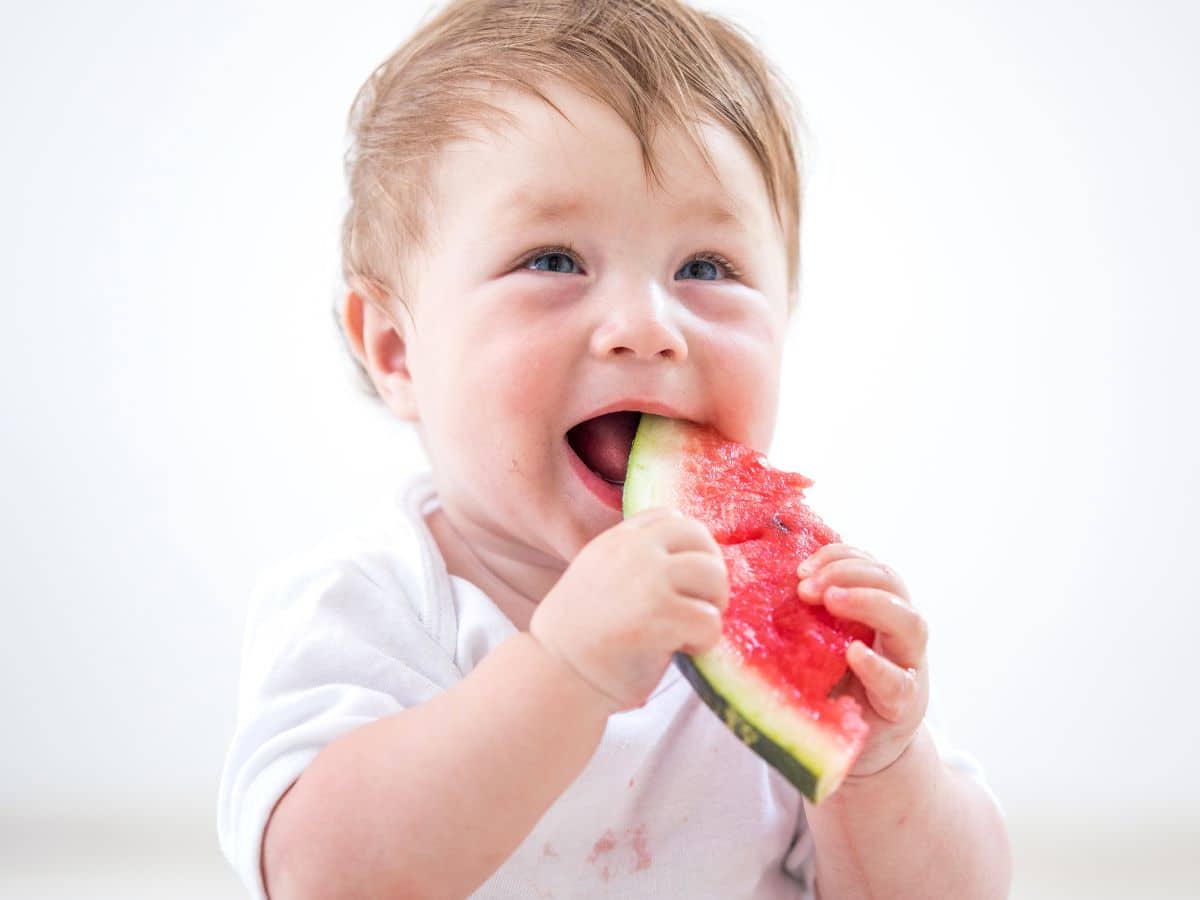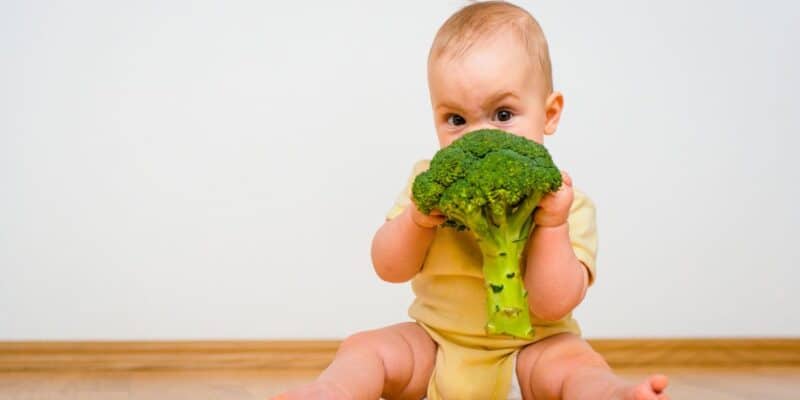So you have decided to opt for the baby led weaning method and are now ready embark on this exciting journey with your baby! But where do you start? What do you need?
And most importantly how should you prepare the food? Cutting the food items in the manner that is manageable for your baby is key when choosing the baby led weaning method.
This is because the success of this method will depend on your baby’s ability to pick up the food items independantly and take it to their mouth.
This article will discuss how you should be cutting the foods and also other factors that are important when considering baby led weaning.
As an Amazon Associate, I earn from qualifying purchases. The links below may be affiliate links. Please read my disclosure policy for more information.
Benefits of Baby Led Weaning

Research carried out into baby led weaning has highlighted many benefits of this method of feeding babies.
Babies are able to develop fine motor skills by using their hands and taking the food item to their mouth. This also develops their hand eye co ordination.
Since they are feeding themselves, they are deciding how much food they want. This therefore leads to less fussiness and tantrums during mealtimes.
For the parents it is more convenient, since there is less food preparation involved and you no longer have to batch cook and blend purees!
BLW also allows babies to feel a sense of independence which develops their confidence in other areas of their development such as crawling, walking and talking.
This method of feeding also teaches babies how to make decisions and choices, since a number of food items are placed in front of them and they choose what they would like to eat. This is a key life skill being developed at this early stage of their weaning stage.
It also allows them independence and choice of how much to eat and at which pace – something not possible with spoon led feeding. This therefore allows babies to respond to hunger and fullness cues better.
One of the biggest advantages of BLW is the prevention of obesity since the chances of babies becoming overweight are minimal where they are choosing how much they wish to eat. This sets them up for positive life long eating habits.
BLW also allows families to eat the same food together since the baby can be offered foods from the main meal.
How Should The Food Be Cooked?

Since your baby still doesn’t have a set of teeth to chew with, it’s important that all vegetables and fruits are cooked until their are soft. Your baby should be able to chew using their gums without having to work very hard at the initial stage.
However, if the foods are too mushy or overcooked, then your baby will struggle to grab it into their hands. It will squash in their hands before they get a chance to take it up to their mouth.
How Should I Cut My Baby’s First Foods?
As a rule of thumb, the foods should be cut so that the pieces are thick enough for your baby to pick up and handle with ease. At the age of six months, babies use their entire hand as opposed to just their fingers.
The food should be cut so that your baby can close their hand around the piece. Therefore, it can’t be cut too wide as to make it difficult for the infant to wrap their hand around it.
Not only should the food items be cut to the correct width and thickness, but also the length is important. Long pieces of food are easier for your baby to handle and pick up.
As a recommendation, starter foods should be cut 5-6cm long so that only half of the food item is covered with your baby’s hand and the other half is free to be bitten and chewed from.
Some Examples

Carrot
Peel your carrot, and cut it into long thick strips. You can either steam your carrot or bake it in the oven until it is softer.
Sweet Potato Wedges
Cut your sweet potato in half and then cut each piece in half again to make wedges. These should be half an inch thick.
Place them on an oven tray and drizzle some olive oil over them. Roast until they are soft but not too mushy.
Roasted Apple Wedges
Pre heat your oven and slice your apples into wedges approximately 1/2 inch thick. Place them on to your baking tray and drizzle with butter.
If you wish you can add some cinnamon powder on top although best to avoid it if it is a starter food for baby during the first stages of weaning.
You will know when the apples are done as they’ll be tender when poked with a knife or fork. You can offer these apples with yoghurt or porridge.
Broccoli
You can purchase long tender-stems which are easy for baby to grasp and hold. These can be steamed using a steam basket or a steamer pot.
Alternatively you can purchase florets. Drizzle olive oil over a baking tray and coat the florets in it. Roast it in the oven until it starts to turn brown.
Banana
A popular method of offering BLW babies banana, is to cut it in half and then cut the top half of the skin off whilst keeping the bottom half of the banana’s skin on.
This allows the infant to grab the banana from the bottom half without mushing it whilst still being able to chew from the top half.
Toast Sticks
Cut these 1/2 inch wide so they are thick enough to be grabbed from the plate. This is one of the most versatile options since you can use a variety of spreads from mashed avocado, to cream cheese and peanut butter.
Melon / Mango
Cut these up in long thick slices to avoid choking. Make sure the fruit is very ripe and there’s no choking hazard.
When Can I Offer Family Foods At Meal Times?
Once your baby is comfortable with the motion of picking up foods from their plate and taking it into their mouth, then you might want to offer them the meal you are eating as a family. But be mindful, raw vegetables and food items should only be offered once your baby has a full set of teeth.
You can offer pieces of cooked boneless fish. Try to keep the the pieces big so they can grasp it especially if their pincer grip is not yet developed.
Roast chicken is also another great option as you can cut long strips of chicken. These can be offered with roasted carrots and potatoes.
Pasta is another great family dish that can include your baby. Offer them pasta either penne or spaghetti or lasagna strips. At first start by offering them plain pasta, and then with sauce such as bolognese or pesto or cabonara.
Omlettee during breakfast is also a great option for inclusive family meals. Simply fry the omelette in butter and cut into long strips. Over time you may want to add in some condiments.
Choking vs Gagging
Gagging reflex is natural and very common when babies first start weaning. This is because they are adjusting to the motion of pushing solid food down the back of their tongue.
The gagging reflex is their natural instinct kicking in out of fear of choking. Do not be alarmed if your baby gags however remember adult supervision is imperative when your baby has solid foods in front of them.
Many people wrongly associate choking with baby led weaning. Your baby will learn to move the food around in their mouth and attempt to chew it with their gums before trying to swallow it.
Always keep your baby in an upright position when offering food items. Do not offer raw hard fruits or vegetables if they do not have teeth, such as apples and carrots. Items to avoid include nuts and seeds.
If you notice your baby is struggling to breathe or is gasping for air and the color is draining from their face and your baby is turning blue, please call the emergency services immediately. Your baby may be unable to make a sound if food is blocking their air pipe.

Useful Tips
If you baby starts to fuss or is not interested in the food you have offered to them, then don’t hesitate to take away the plate and try again another time. Your baby will not always be ready to take food up to their mouth.
If you hear your baby gag, don’t be alarmed. Gagging during weaning is very normal and its a natural reflex during a time when your baby is learning how to move food down to the back of their tongue. Swallowing solids is a new experience for them and as they become more accustomed to chewing and swallowing, the gagging will be become rare.
Keep floor wipes for the floor, table wipes for the surrounding areas of the high chair and wet water wipes for your babies hands and mouth for a quick clean after each feeding session.
Don’t be alarmed by the amount of food your baby is consuming, BLW is all about following your baby’s lead. This stage is supposed to be about training your baby to eat independently therefore the focus is less what and more on how.
It is extremely important you do not leave your baby unattended with food at any time. Your baby is at an age where they can choke therefore adult supervision is imperative.
Before you begin to introduce solids, purchase some handy items for your baby. These may include a weaning bib, trainer cup, suction plate and easy grip utensils. These items will aid your weaning journey.
Conclusion
As discussed in this article, there are many different factors to consider when choosing baby led weaning as the method to wean your baby.
It is important you are prepared before you begin offering starter foods to your baby. Unpreparedness can cause your baby distress and also disrupt their weaning journey.
Cutting your baby’s food items in the correct way will make all the difference between your baby picking up the food or leaving it. Remember not to overcook the fruits and vegteables!









